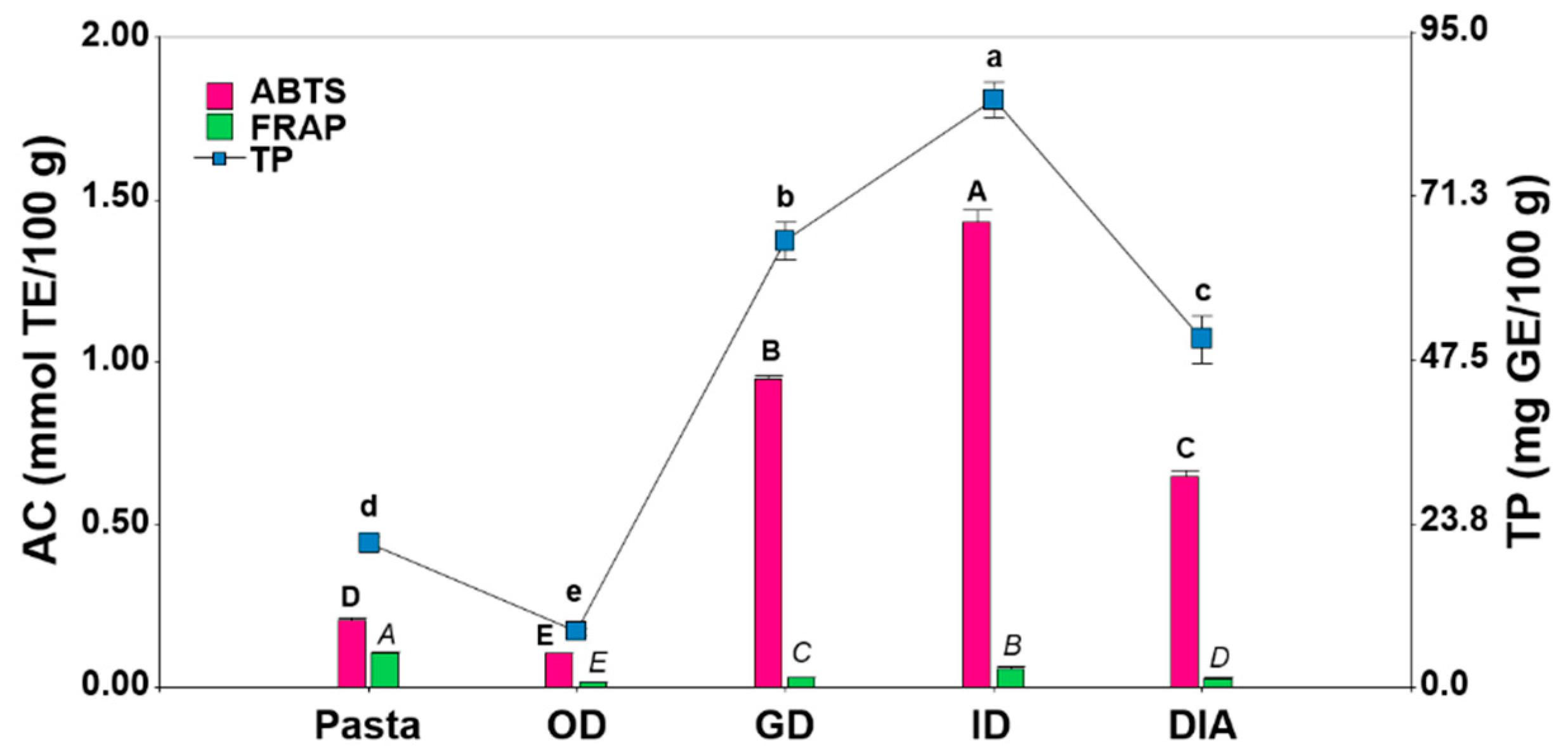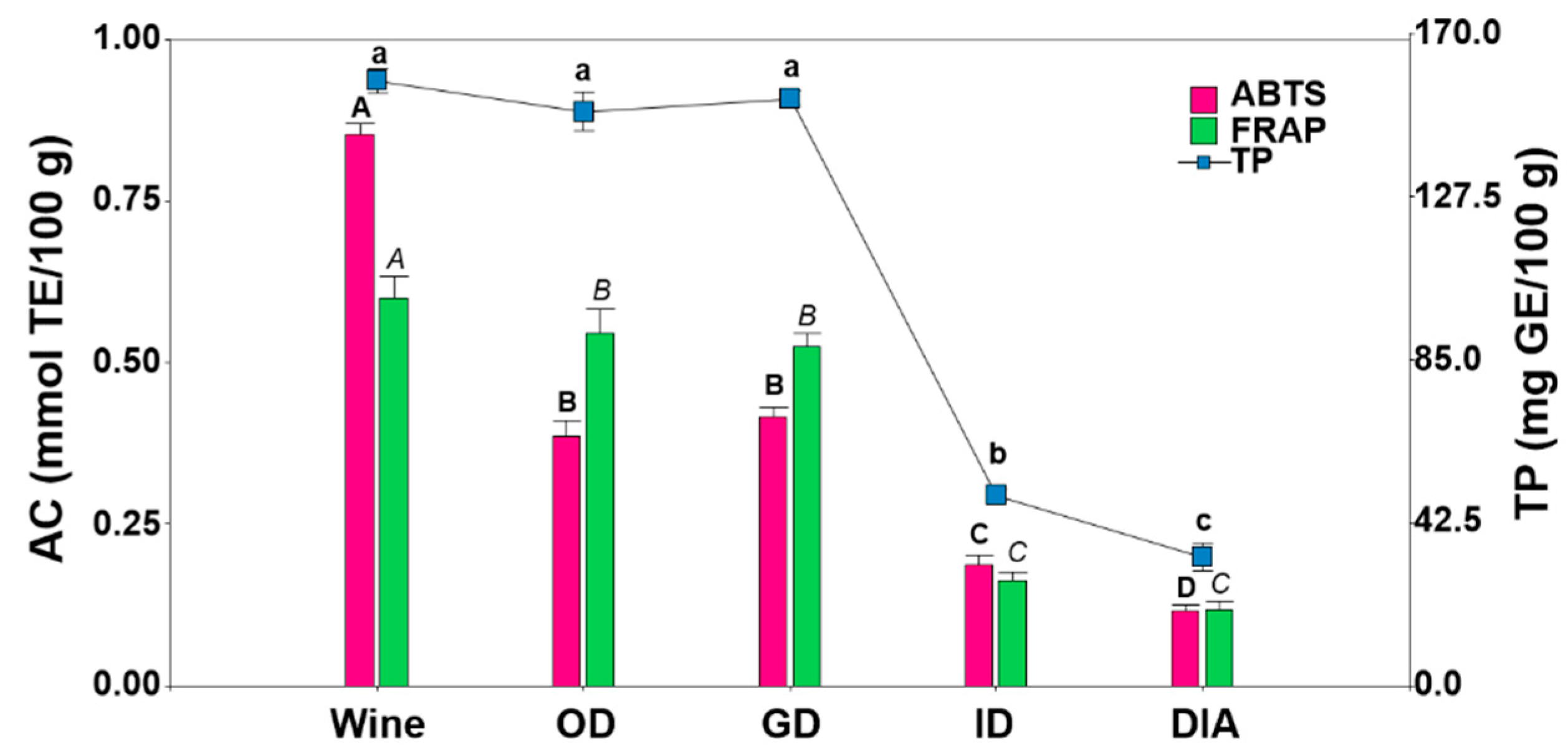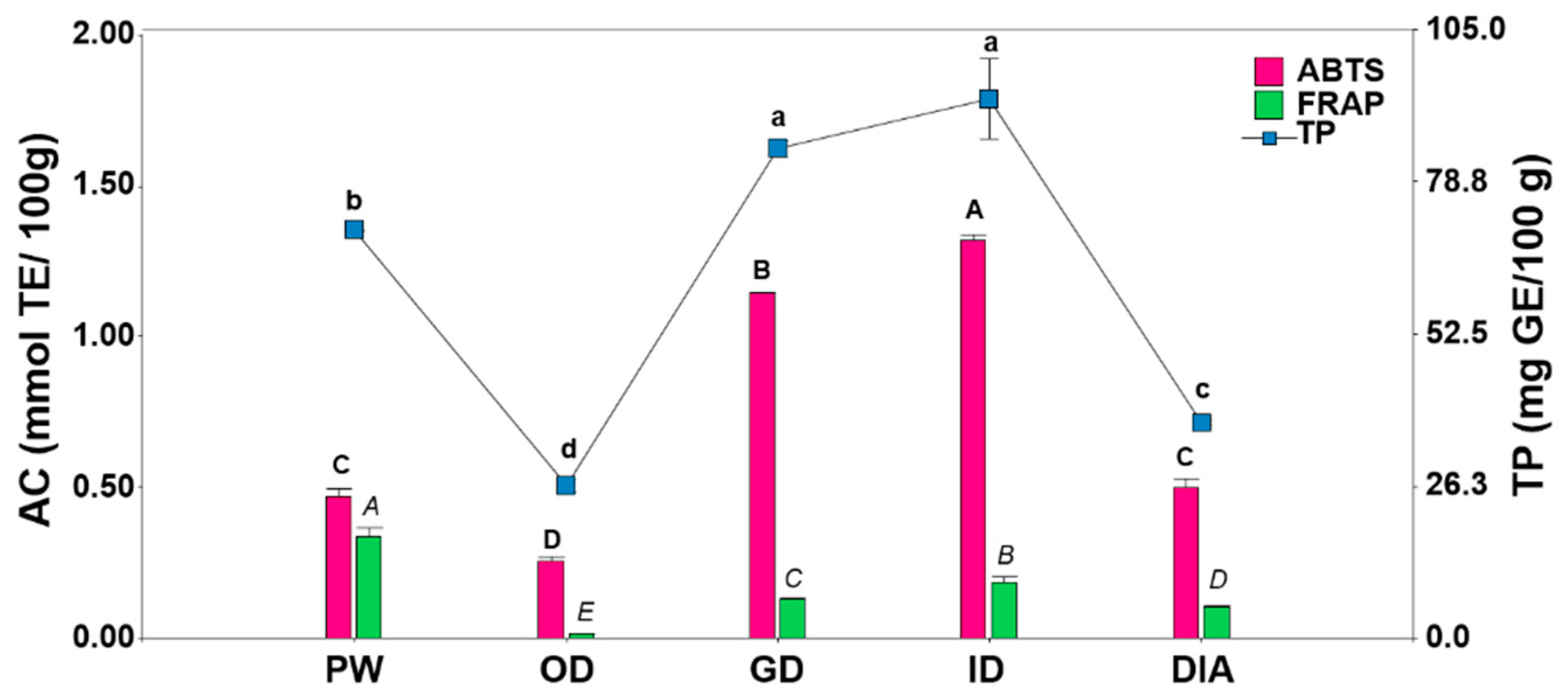1. Introduction
Dietary polyphenols have received considerable interest because of their possible role as antioxidant compounds in the prevention of various diseases associated with oxidative stress, such as cardiovascular diseases, cancer, and inflammation, among others [
1]. These compounds have been characterized in different food and beverages of plant origin [
2]. Additionally, an important number of reports showed the effect of processing on the antioxidant properties (phenolic content and antioxidant capacity) of food rich in polyphenols [
3,
4]. Furthermore, some works have been published in the last years showing the digestibility and the bioaccessibility of these antioxidant compounds in different foods [
4,
5]. In the real-life, a dish of food is composed of two or more types of foods. In this sense, some studies about the co-ingestion/digestion of foods show that interactions of polyphenols with food matrix modifies their bioaccessibility increasing in some cases the antioxidant capacity in the dialyzed fraction, which denotes the serum bioavailability, instead of consuming them alone [
6,
7,
8]. It is important to remember that only those polyphenols capable of surviving the action of processing, digestibility, and co-digestion would be potentially bioavailable to exert their effect (bioactivity) on the human organism [
9].
Pasta and wine are important components of the daily Mediterranean diet, being consumed worldwide. Both are a significant source of health beneficial antioxidant compounds, such as polyphenols. However, the effective antioxidant capacity (AC) of polyphenols requires that they are able to remain unaltered after the digestion and absorption processes, reaching the target organ. To our knowledge, there are no studies showing the impact of the simultaneous consumption of pasta and red wine on the bioaccessibility of their bioactive compounds. Because of this, the aim of this study was to verify changes in the AC of both pasta and wine when co-digested.
2. Materials and Methods
2.1. Samples
Commercial Argentinean wheat (
Triticum aestivum) variety was used in this study: ACA 315 from ASOCIACIÓN de COOPERATIVAS ARGENTINAS (ACA). This variety was selected because of its antioxidant properties according to previously published results [
9].
Argentinean red wine samples (
Vitis vinifera L. cv Syrah), were obtained from the “Antonio de la Torre” winery, located in the Province of San Juan, Argentina. This variety was selected because of its antioxidant properties according to published results [
10,
11].
2.2. Whole-Wheat Pasta Making
Whole-wheat flour was obtained after wheat seeds were chopped with a coffee grinder. The elaboration of whole-wheat pasta was carried out using the methodology described by Podio et al., 2019 [
4].
2.3. Pasta and Wine Combination
Two grams of cooked pasta and 3 mL of red wine were combined to simulate the co-ingestion of a whole-wheat pasta dish and a glass of red wine (PW). These portions were considered following the recommended servings of pasta (65 g) and wine (100 mL) [
12].
2.4. Bioaccessibility of Polyphenols in Food
The in vitro digestion procedure was performed according to the methodology described by Lingua et al. (2018) and Podio et al. (2019) [
4,
5]. Four subsamples were collected: oral digestion (OD), gastric digestion (GD), intestinal digestion (ID), and dialysate (DIA). Blanks of reagents were also made in each step of the in vitro digestion.
2.5. Polyphenol Extraction in Food
The extraction of polyphenols in pasta and PW was performed according to the protocol described by Podio et al. (2017) [
9]. Wine samples were analysed without previous treatment.
2.6. In Vitro Chemical Determinations
2.6.1. Total Polyphenol Content
Total polyphenol content (TP) was measured by the Folin-Ciocalteu method according to the methodology described by Podio et al. (2019) [
4]. Results are expressed in mg of gallic acid equivalents (GAE) per 100 g of fresh food. All samples were analysed in triplicate.
2.6.2. Antioxidant Capacity
In vitro antioxidant capacity (AC) was measured according to Podio et al. (2017 and 2019) and Lingua et al. (2018) [
4,
5,
9], using the ABTS radical-scavenging capacity assay, and the ferric reducing ability of plasma (FRAP) assay. All samples were analysed in triplicate. The results were expressed in mmol of Trolox equivalent (TE) per 100 g of fresh food.
2.7. Polyphenol Profile by HPLC-MS/MS
Phenolic profile was analysed in pasta, wine, PW, ID, and DIA samples by a tandem PDA-ESI-MS/MS (HRMS using a Bruker Micro QTOF II equipment) according to Podio et al. (2017) and Lingua et al. (2018) [
5,
9]. Quantification was performed using external calibration curves from available phenolic standards. All samples were analysed in triplicate. The results were expressed in mg of standard equivalent per 100 g of fresh food.
2.8. Statistical Analysis
Results were analysed using the Infostat software package [
13]. Analysis of Variance (ANOVA) was performed using mixed models [
14]; in the case of significance (
p < 0.05), a DGC [
15] comparison test was performed to reveal paired differences between means.
3. Results and Discussion
The bioaccessibility and the antioxidant capacity (AC) of the polyphenols present in cooked whole-wheat pasta, red wine, and pasta-wine dish (PW) as well as the changes during the simulated gastrointestinal digestion were analysed in 3 stages: oral digestion (OD), stomach digestion (GD), and digestion + absorption of polyphenolic compounds in the small intestine (two subsamples: intestinal digestion (ID), and dialysate (DIA)). DIA sub-samples represent the potentially bioaccessible fraction of polyphenols, which would pass into the bloodstream from the small intestine by passive diffusion, reaching organs or tissues where they would exert their antioxidant action. ID subsamples could be extrapolated to the polyphenols passing into the colon, which could affect the gut microbiome. Although this model does not include active absorption of polyphenols through the small intestine, it is a relatively simple way to approximate results to a real in vivo digestion.
3.1. Antioxidant Properties of Pasta
Figure 1 shows the results of the TP and the AC in cooked whole-wheat pasta extracts and in the different steps of gastrointestinal digestion.
A significant drop in the TP and the AC was observed in the OD with respect to pasta. Additionally, GD, ID, and DIA showed higher values of TPC and ABTS than those corresponding to OD and pasta. Moreover, FRAP values for GD, ID, and DIA were higher than those observed for OD but lower than pasta. The same trend was observed by Podio et al. (2019) and could be explained by an increase of bioactive compounds released from the food matrix during the digestion [
4].
Table S1 shows the polyphenols identified and quantified in pasta, ID, and DIA samples. Only 6 out of the 23 starting compounds in pasta were quantified in ID. They were: HBADG, HBAG, Try, 8G6AA, 6G8AA, and DFA 6. These 6 compounds plus
tFA also were found in DIA samples. The compounds found in DIA would be the responsibility of the AC observed in these samples (
Figure 1) and they could be the most relevant compounds to explain the AC of pasta after gastrointestinal digestion.
3.2. Antioxidant Properties of Wine
Figure 2 shows the results of the TP and the AC of red wine and in different steps of its gastrointestinal digestion.
The TP in the wine after OD was conserved, however, a significant drop of the AC was observed. From OD to intestinal digestion (ID and DIA), the TP showed the same trend as the AC did; namely, it was maintained from OD to stomach digestion, and then stepwise decreased after intestinal digestion. The same trend was observed by Lingua et al. (2018) [
5]. In the liquid matrix, as in wine, the polyphenols in the mouth and stomach are already bioaccessible, however, intestinal digestion reduces their bioaccessibility mainly due to the alkaline pH of the digestive fluid [
5].
Table S2 shows the polyphenols identified and quantified in wine, ID, and DIA samples. Only 10 out of 23 compounds quantified in wine could be quantified in ID samples. They were CA, CouA, EG, FeA, Cat, Epi, Ast, QuerGlcr, IsoQ, and SyrGlc. While only 9 out of 23 starting compound in wine (CA, CouA, FeA, Cat, Epi, Ast, LarGlc, QuerGlcr, and SyrGlc) were found in DIA samples; therefore, these 9 compounds would be the responsibility of the observed AC in these samples (
Figure 2). Furthermore, they could be the most relevant compounds to explain the AC of wine after gastrointestinal digestion.
3.3. Antioxidant Properties of Pasta and Wine Co-Digestion
Figure 3 shows the TP and the AC of combined foods (pasta and wine co-digestion, PW).
A significant decrease of the TP and AC was observed in OD with respect to the corresponding PW. Furthermore, GD and ID showed higher values of TP and ABTS than those corresponding to OD and PW. Moreover, FRAP values for GD, ID, and DIA were higher than those observed for OD but lower than PW. These results have the same trend that those found in pasta (
Figure 1).
When the pasta and wine co-digestion results (experimental results or PW exp) are compared with those of the sum of the individual food digestions (estimated results P + W, or PW est) (
Table 1), it can be seen that the experimental co-digestion decreases the TP determined in food, OD, and GD. Concerning to AC, experimental co-digestion increases the ABTS in GD and ID steps but decreases the FRAP in OD and GD. Finally, the DIA step didn’t show differences in AC and TP between experimental and estimated co-digestion, however, differences in the bioaccessibility of some phenolics were found.
Table S3 shows the polyphenols identified and quantified in PW, ID, and DIA samples for experimental and estimated co-digestion foods. In the case of ID samples, an increase of HBADG, HBAG, 8G6AA, DCF 3, CafA, DimProc, MyrGlc, Ast, LarGlc, QuerGlcr, and IsoGlc was observed in experimental co-digestion with respect to estimated. However, we observed that DFA 6, FeA, and IsoQ were decreased. Finally, the experimental results show that the simultaneous ingestion/digestion of pasta with wine increased the bioaccessibility (DIA samples) of HBADG, 8G6AA, 6G8AA, DFA 3, GA, CA, CafA, EG, and DimProc, but decrease the bioaccessibility of DFA 6,
tFA and FeA.
It is worth telling that the compounds quantified in dialysate sub-samples (DIA) are the bioaccessible and dialyzable fraction of polyphenols, passing into the bloodstream to reach organs or tissues where they would exert their antioxidant action. Therefore, the increase of the bioaccessibility of these compounds when pasta and wine are consumed together (
Table S3) probe that this co-digestion seems to be a beneficial practice to increase the potential positive effects of the polyphenols present in both pasta and wine.
4. Conclusions
The consumption or co-ingestion of pasta with wine improves the antioxidant properties of these foods modifying the bioaccessibility of polyphenols pointing out the importance of further studies on co-digestion for different foods/beverages. To our knowledge, the current study is the first that provides valuable insights into the changes taking place during the simulated gastrointestinal digestion of a dish of pasta with a cup of red wine.
Supplementary Materials
The following are available online at
www.mdpi.com/xxx/s1, Table S1: Polyphenolic compounds (mg/100 g fresh food) in cooked pasta and in ID and DIA steps of gastrointestinal digestion. Values are reported as mean ± SD. Different letters in the same row indicate significant differences (
p < 0.05): a > b > c. N.D. means not detected., Table S2: Polyphenolic compounds (mg/100 g fresh food) in red wine and in ID and DIA steps of gastrointestinal digestion. Values are reported as mean ± SD. Different letters in the same row indicate significant differences (
p < 0.05): a > b > c. N.D. means not detected., Table S3: Polyphenolic compounds (mg/100 g fresh food) in combined foods and in ID and DIA steps of gastrointestinal digestion. Values are reported as mean ± SD.
* significant differences (
p < 0.05) between experimental and estimated in the different samples studied. N.D. means not detected.
Author Contributions
Conceptualization, M.S.L. and N.S.P.; methodology, M.S.L. and N.S.P.; software, M.S.L. and N.S.P.; validation, M.S.L., N.S.P., M.V.B. and D.A.W.; formal analysis, M.S.L. and N.S.P.; investigation, M.S.L. and N.S.P.; resources, M.V.B. and D.A.W.; writing—original draft preparation, M.S.L. and N.S.P.; writing—review and editing, M.S.L., N.S.P., M.V.B. and D.A.W.; supervision, M.V.B. and D.A.W.; project administration, M.V.B. and D.A.W.; funding acquisition, M.V.B. and D.A.W. All authors have read and agreed to the published version of the manuscript.
Funding
This research was funded by CONICET (PIP 11220110101051), FonCyT (PICT 05054), and SECyT, Universidad Nacional de Córdoba.
Acknowledgments
We would like to express our gratitude to the Asociación de Cooperativas Argentinas (ACA) for providing wheat samples and to Antonio de la Torre cellar for providing wine samples.
Conflicts of Interest
The authors declare no conflict of interest.
References
- Costa, C.; Tsatsakis, A.; Mamoulakis, C.; Teodoro, M.; Briguglio, G.; Caruso, E.; Tsoukalas, D.; Margina, D.; Dardiotis, E.; Kouretas, D.; et al. Current evidence on the effect of dietary polyphenols intake on chronic diseases. Food Chem. Toxicol. 2017, 110, 286–299. [Google Scholar] [CrossRef] [PubMed]
- Shahidi, F.; Ambigaipalan, P. Phenolics and polyphenolics in foods, beverages and spices: Antioxidant activity and health effects—A review. J. Funct. Foods 2015, 18, 820–897. [Google Scholar] [CrossRef]
- Baroni, M.V.; Gastaminza, J.; Podio, N.S.; Lingua, M.S.; Wunderlin, D.A.; Rovasio, J.L.; Dotti, R.; Rosso, J.C.; Ghione, S.; Ribotta, P.D. Changes in the Antioxidant Properties of Quince Fruit (Cydonia oblonga Miller) during Jam Production at Industrial Scale. J. Food Qual. 2018, 2018, 1–9. [Google Scholar] [CrossRef]
- Podio, N.S.; Baroni, M.V.; Pérez, G.T.; Wunderlin, D.A. Assessment of bioactive compounds and their in vitro bioaccessibility in whole-wheat flour pasta. Food Chem. 2019, 293, 408–417. [Google Scholar] [CrossRef] [PubMed]
- Lingua, M.S.; Wunderlin, D.A.; Baroni, M.V. Effect of simulated digestion on the phenolic components of red grapes and their corresponding wines. J. Funct. Foods 2018, 44, 86–94. [Google Scholar] [CrossRef]
- Kamiloglu, S.; Pasli, A.A.; Ozcelik, B.; Capanoglu, E. Evaluating the in vitro bioaccessibility of phenolics and antioxidant activity during consumption of dried fruits with nuts. LWT-Food Sci. Technol. 2014, 56, 284–289. [Google Scholar] [CrossRef]
- Kamiloglu, S.; Capanoglu, E.; Bilen, F.D.; Gonzales, G.B.; Grootaert, C.; Van de Wiele, T.; Van Camp, J. Bioaccessibility of Polyphenols from Plant-Processing Byproducts of Black Carrot (Daucus carota L.). J. Agric. Food Chem. 2016, 64, 2450–2458. [Google Scholar] [CrossRef] [PubMed]
- Kan, L.; Oliviero, T.; Verkerk, R.; Fogliano, V.; Capuano, E. Interaction of bread and berry polyphenols affects starch digestibility and polyphenols bio-accessibility. J. Funct. Foods 2020, 68, 103924. [Google Scholar] [CrossRef]
- Podio, N.S.; Baroni, M.V.; Wunderlin, D.A. Relation between polyphenol profile and antioxidant capacity of different Argentinean wheat varieties. A Boosted Regression Trees study. Food Chem. 2017, 232, 79–88. [Google Scholar] [CrossRef] [PubMed]
- Lingua, M.S.; Fabani, M.P.; Wunderlin, D.A.; Baroni, M.V. From grape to wine: Changes in phenolic composition and its influence on antioxidant activity. Food Chem. 2016, 208, 228–238. [Google Scholar] [CrossRef] [PubMed]
- Lingua, M.S.; Fabani, M.P.; Wunderlin, D.A.; Baroni, M.V. In vivo antioxidant activity of grape, pomace and wine from three red varieties grown in Argentina: Its relationship to phenolic profile. J. Funct. Foods 2016, 20, 332–345. [Google Scholar] [CrossRef]
- Raciones-Recomendadas-SENC-2016. Available online: https://www.ucm.es/data/cont/docs/458-2017-01-29-Raciones-recomendadas-SENC-2016.pdf (accessed on 9 January 2020).
- Di Rienzo, J.A.; Casanoves, F.; Balzarini, M.G.; González, L.; Tablada, M.; Robledo, C.W. InfoStat; versión 2008; Grupo InfoStat, FCA, Universidad Nacional de Córdoba: Córdoba, Argentina, 2008. [Google Scholar]
- Di Rienzo, J.A.; Macchiavelli, R.; Casanoves, F. Modelos Mixtos en InfoStat; Grupo InfoStat, FCA, Universidad Nacional de Córdoba: Córdoba, Argentina, 2010. [Google Scholar]
- Di Rienzo, J.A.; Guzmán, A.W.; Casanoves, F. A Multiple-Comparisons Method Based on the Distribution of the Root Node Distance of a Binary Tree. J. Agric. Biol. Environ. 2002, 7, 129–142. [Google Scholar] [CrossRef]
| Publisher’s Note: MDPI stays neutral with regard to jurisdictional claims in published maps and institutional affiliations. |
© 2020 by the authors. Licensee MDPI, Basel, Switzerland. This article is an open access article distributed under the terms and conditions of the Creative Commons Attribution (CC BY) license (https://creativecommons.org/licenses/by/4.0/).







